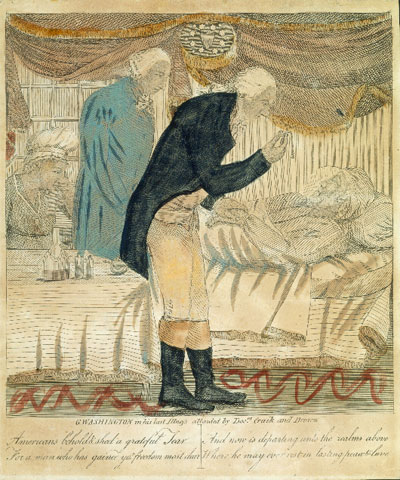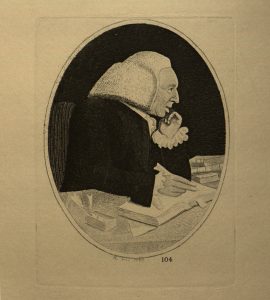
The Gustavus Richard Brown lecture notes in our archives include four notebooks of lectures made by Gustavus R. Brown while he was a student at the University of Edinburgh Medical School in 1766-1768. The four volumes in the collection are: 1-2. Lectures on physiology by William Cullen, 1766-1767; 3. Cullen’s practice [of physic] by William Cullen, and 4. Doctor Young on midwifery by Thomas Young, 1767-1768.
When I came across these 18th century manuscripts cataloged separately in the rare book collections, I had questions. What is their provenance or how did they come to our medical library? Who were William Cullen and Thomas Young, G.R. Brown’s teachers at the University of Edinburgh? And who was Gustavus Richard Brown? What is the significance of G.R. Brown’s lecture notes?
Provenance
This collection of G.R. Brown’s student notebooks came to The Bernard Becker Medical Library as part of the St. Louis Medical College Library. Each notebook has a bookplate of the St. Louis Medical College Library. St. Louis Medical College was a proprietary medical school in St. Louis, MO that became Washington University’s medical department when it affiliated with Washington University in 1891. Volumes 1 and 2, Cullen’s lectures on physiology, have consecutive accession numbers and the same note on the bookplate: “Donated by G. R. Brown.” But Volumes 3 and 4, Cullen’s Practice of Physic and Doctor Young on midwifery, have nonconsecutive accession numbers and no donor information on the St. Louis Medical College book plates. However, the signature of Vernon H. Dorsey is in both Volumes 3 and 4. So Dorsey of Port Tobacco, Virginia, had these two volumes in his library at some time.
William Cullen (1710-1790) and Thomas Young (1726?-1783) at the University of Edinburgh

The University of Edinburgh was the foremost medical school of mid-eighteen century Europe. Many of the faculty was European trained and recruited from Leyden and included Alexander Monro, John Rutherford, and Robert Whytt. John Rutherford got permission to give clinical lectures in the Royal Infirmary in 1748. He modelled his clinical lectures in the wards after lectures he attended while a student at Leyden. From 1748 on, clinical lectures in the Royal I infirmary were a regular feature of medical training at the University of Edinburgh.
William Cullen and Thomas Young both began teaching at the University of Edinburgh in 1756. The year 1756 was ten years before 19 year old G. R. Brown came from America to study medicine at the University of Edinburgh. In 1756, William Cullen gave at Edinburgh the first public demonstration of the refrigeration effects of evaporative cooling. “Cullen used a pump to create a partial vacuum over a container of diethyl ether, which then boiled, absorbing heat from the surroundings. This created a small amount of ice, but the process found no commercial application.”
William Cullen was also an innovative teacher who was amonge the first to give his lectures in English rather than Latin. His lectures in English drew students like G. R. Brown from the whole English speaking world to the University of Edinburgh medical school. Cullen had prior experience teaching chemistry and physiology from similar posts at the University of Glasgow, 1746-1756. He began teaching practice of medicine with John Gregory as well in 1766.
Young also had great influence over the hundreds of Scottish, English, Irish and American students like G. R. Brown who attended his course in midwifery over a period of twenty-five years. He offered this course in midwifery in 1756. He was also the first to provide clinical lectures to medical students in the lying-in-ward that he established at the Royal Infirmary in 1751. This ward had special status and Dr. Young provided significant funds for its expenses. As late as 1764, students who didn’t attend the Infirmary were allowed to purchase special tickets entitling them to attendance for each course on the lying in ward which lasts about ten weeks.” Examination of other lecture notes on midwifery given by Doctor Young over a period of 20 years show that he constantly revised his lectures. He added new or revised observations, new case histories as they occurred in his practice, and even added new lectures. In final form the course consisted of 50 lectures given from written notes. The earlier notes were half this length.
So William Cullen taught G.R. Brown, a young man from Maryland about physiology and the practice of medicine in forceful inspiring lectures given in English. Because it was standard practice at Edinburgh by that time, Cullen gave the clinical lectures on the practice of medicine in the Royal Infirmary. Thomas Young also gave his clinical lectures on midwifery in a special section of the Royal Infirmary, the Lying-In Ward,.
Gustavus Richard Brown (1747-1804)
Gustavus Richard Brown (1747-1804) was a physician and a botanist, who was a lifelong friend of George Washington. The engraving of Washington’s death from the Mount Vernon Website shows Drs. James Craik and G. R. Brown attending George Washington at his death, December 12, 1799. This depiction of Dr. Brown shows a tall man; he was over six feet in height and 52 years old. Craik called Brown to the bedside of George Washington during his last illness, because he had an excellent reputation for diagnosis and moderate medicating. “He is said to have used few remedies but those of the most efficient character.” Like all doctors of his time, G. R. brown used blood-letting as a treatment to balance the fluids or humors in Washington’s body. (George Washington’s Mount Vernon 2014) In a letter to Dr. Craik after Washington’s death, “he acknowledges that they were wrong in bleeding Washington so much.”
Gustavus Richard Brown (1747-1804) was a lifelong friend of George Washington. He was born near Port Tobacco, Maryland to Dr. Gustavus Brown (1689-1765) and Mrs. Margaret Black Boyd, his father’s second wife. Dr. Gustavus Brown I., who earned his M.D. at the University of Edinburgh, came to Maryland from Scotland in 1708 and was welcomed into the Port Tobacco community as its doctor. Gustavus R. Brown was educated at his father’s alma mater, earning his doctor in medicine in 1768 with his inaugural dissertation, De ortu animalium caloris.
After walking the London hospitals for several months, G.R. Brown returned to his ancestral home, bringing with him a large collection of plants and flowers collected by him at a stop at the Madeira Islands. He practiced medicine first in Namjemoy and later in Port Tobacco, Charles County, Maryland.
In 1776, during the American Revolution, G.R. Brown and his nephew, Dr. James Wallace founded a hospital for the inoculation of smallpox near the Potomac River on the Virginia side. From the close of the revolution until his death, he was the favorite preceptor with medical students from adjacent regions in Maryland and Virginia. They came to study at “Rose Hill” near Port Tobacco with its large and elegant house and a 10-acre garden and hothouse with rare and medicinal plants. Connected to the house by a covered walk was “another brick house used by G. R. Brown as an office and for his medical school; there he received and trained ten young men at a time. A large well lighted basement was used as a dissecting-room.”
In 1799, he was instrumental in the founding of the state medical society, the Medical and Chirurgical Faculty of Maryland. Dr. G.R. Brown was in active practice until his last short illness. He died five years after Washington’s death at “Rose Hill,” near Port Tobacco, September 30, 1804.
Significance
Lecture notes are not commonly used in our archives compared to correspondence or diaries. Yet Lectures on physiology by William Cullen, 1766-1767 was used in the past month. I have helped at least 2 other users with Cullen lecture notes since 2001. The significance of the lecture notes often depends on who the lecturer was and the reputation of the medical school or university where they were given. William Cullen was one of the first lecturers in a medical school to teach in English rather than Latin, an innovation which drew students from the whole English speaking world to the University of Edinburgh medical school. The University of Edinburgh medical school was the foremost in Europe at that time.
Bibliography
Cordell, Eugene F. The medical annals of Maryland, 1799-1899; prepared for the centennial of the Medical and chirurgical faculty. Baltimore: Press of Williams & Wilkins company, 1903, p. 20, 334 http://archive.org/stream/medicalannalsofm00cord/medicalannalsofm00cord_djvu.txt
Cordell, Eugene F., M.D. “IX. The founders from the Western shore of Maryland.” Maryland Medical Journal, Volume 42, no. 7 (Baltimore, August 12, 1899), p. 94-96 http://books.google.com/books?id=GiATAAAAYAAJ&pg=PA94&dq=
G. Washington in his last illness attended by Thos Craik and G.R. Brown, 1799″ Illustration copied from “The Death of George Washington,” accessed July 1, 2014, http://www.mountvernon.org/george-washington/death
Encyclopædia Britannica Online, s. v. “William Cullen,” accessed June 30, 2014, http://www.britannica.com/EBchecked/topic/146062/William-Cullen.
Hoolihan C. “Thomas Young, M.D. (1726?-1783) and obstetrical education at Edinburgh.” J Hist Med Allied Sci. 1985 Jul; 40(3):327-345.
Kelly, Howard Atwood; Burrage, Walter Lincoln: American Medical Biographies. – Baltimore: The Norman, Remington, Co., 1920, page 153.
